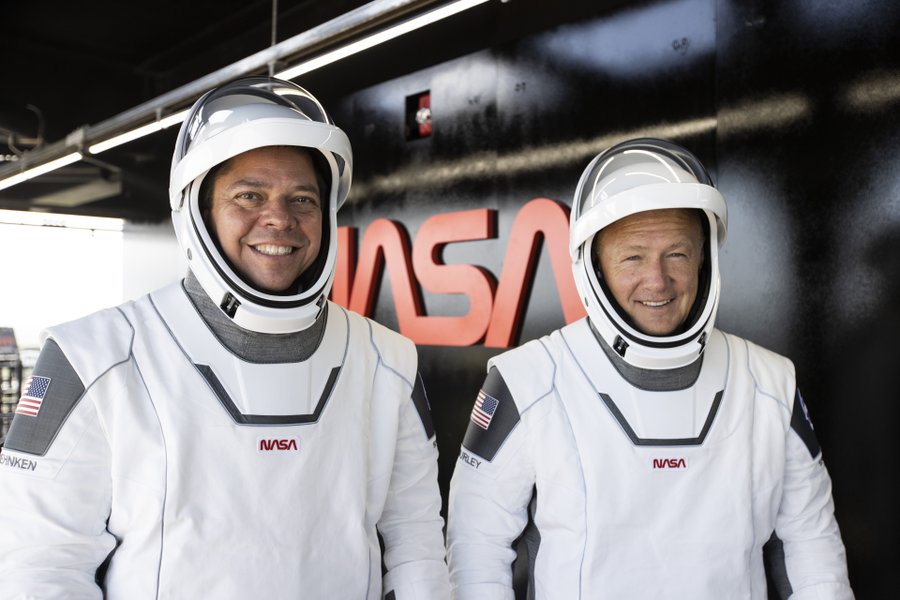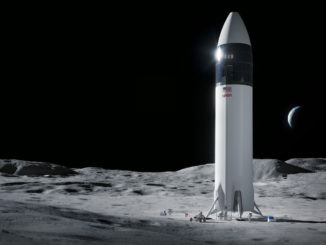STORY WRITTEN FOR CBS NEWS & USED WITH PERMISSION

It’s one thing to watch a spouse blast off on a rocketship, especially when the spacecraft is making its first flight with people on board. But it’s altogether another matter when the anxious spouse is an astronaut as well.
That’s the case for Karen Nyberg and Megan McArthur, both veteran astronauts married to the two men who plan to take off aboard a SpaceX Crew Dragon Wednesday for a historic flight to the International Space Station.
It will be the first flight of an American spacecraft carrying NASA astronauts launching from U.S. soil since the space shuttle completed its final mission in 2011. And it will be the first time in space history that astronauts will ride commercially developed American-made rockets and spacecraft not owned and operated by the space agency.
A veteran of two space flights, including a long-duration stay aboard the space station, Nyberg, now retired from the astronaut corps, is married to Crew Dragon commander Douglas Hurley, a two-flight veteran and pilot of the shuttle Atlantis during the program’s final mission. The couple has a 10-year-old son, Jack.
McArthur, who helped service the Hubble Space Telescope during a final shuttle overhaul in 2009, is married to Crew Dragon joint operations commander Robert Behnken, one of Hurley’s best friends. They have a 6-year-old son, Theodore.

By almost any standard, the Hurleys and Behnkens are standouts — even by astronaut standards.
Hurley is a veteran Marine Corps F/A-18 test pilot. Behnken holds a doctorate in mechanical engineering from CalTech and served as an Air Force flight test engineer with the F-22 program. Nyberg holds a Ph.D. in mechanical engineering and McArthur earned a doctorate in oceanography.
All four met after being selected by NASA as part of a 17-member astronaut class in 2000.
“We know how they’re going to feel on launch day,” Hurley said in an interview with CBS News. “And it is way harder on them to watch somebody that you care for get on a rocket and go fly than it is for those two guys on the rocket. I mean, it’s a tough job to be the one watching.
“They understand the risks, they understand the trades, they understand why you’re doing it and how you feel about it. That in itself makes it a lot easier. But I think they understand a lot more in most cases maybe somebody who came from another background.”
Asked how she felt about it, Nyberg said, “I think in some ways you can know too much.”
“But I have so much confidence in the two of them as operators,” she said. “I know if there are any problems, they are cool, calm and collected and (will) work through it. As far as the risk goes, you know, I accepted risk for myself a long time ago and just understand that that’s part of our career.”
Arriving in Florida with a flyby of your dad’s spaceship on the launch pad… Priceless. #LaunchAmerica #CrewDragon pic.twitter.com/qnFIfPsHkM
— Karen L. Nyberg (@AstroKarenN) May 24, 2020
Said McArthur: “It’s comforting to us in a way to have knowledge of the technical challenges that they might be facing, to understand how the teams work when they’re trying to resolve those challenges because it gives you a lot of confidence. As Karen said, it gives you a lot of confidence in the process as they go through this mission.”
Hurley and Behnken have been training for the past several years for their Crew Dragon flight, routinely flying from Houston to the Kennedy Space Center in Florida, to SpaceX headquarters in Hawthorne, California, and various other job-related destinations.
While managing life on the home front is difficult for the spouse who stays behind, the fact that the families are such close friends definitely helps.
“We’ve been friends for 20 years,” said McArthur. “We started together, we’re still friends together, we have kids now who are playing well together. And so sometimes when Bob and Doug are out in California, and we know they’re working hard, we’ll go out to dinner together, we’ll take the boys and go out to dinner together somewhere.
“But as Karen said, it’s just, you know, in any couple (where) both people are working, you kind of hand back and forth that domestic responsibility when somebody else’s work is surging, and it’s not really any different for us. You take the opportunity to support one another when it’s the other person’s turn.”

SpaceX launched an unpiloted Crew Dragon to the space station last year, a test flight flight that went off without a hitch. The company has resolved earlier problems with the parachute system needed to lower the capsule to an ocean splashdown and replaced pressurization mechanisms responsible for an explosion during a subsequent ground test.
In January, SpaceX launched a Crew Dragon atop a Falcon 9 booster and deliberately triggered a rocket-powered abort, showing the spacecraft can quickly and autonomously propel a crew capsule to safety in the event of a catastrophic failure.
Unlike the space shuttle, which had so-called “black zones” during ascent in which unsurvivable propulsion failures were a reality, the Crew Dragon was designed to safely abort at any point from the launch pad to orbit. In addition, the Falcon 9 can suffer one and possibly two first stage engine failures and still reach space.
But Hurley and Behnken will still be riding a rocket, and the risks are higher than most people are used to dealing with.
“We have those discussions inside the house,” Behnken said. “I don’t want to spoil the movie for folks who haven’t seen it, but the ‘First Man’ movie that recently came out, there’s a scene in there where Neil Armstrong is tasked by his wife with explaining to his children what the risk in front of them actually is.
“My son is a little bit on the young side for that explanation, but we’ve had that conversation. That’s part of my job … not put it all on her to make sure that the rest of the family understands as well that there’s risk associated with it. It isn’t all just interviews and laughing and joking around. There’s risk involved, and folks need to appreciate that.”
My son and I took in a recent Falcon 9/Dragon launch together. This is what it took to get his approval for me to be onboard later this month! pic.twitter.com/NUjRZ5EDy6
— Bob Behnken (@AstroBehnken) May 12, 2020
When he explained the flight and his assignment to his son, Theodore, “the only question he had was whether or not the Dragon was going to roar. So they went to Florida where they watched a Dragon cargo ship blast off “and he got to (hear) the roar of the Dragon himself.”
Behnken said he told his son “we’ve done everything we can … to make sure that the Dragon isn’t gonna bite us and if it tries, there’s an escape system that’s going to help us get away from the Falcon.”
“I think the thing I’m most looking forward to is being able to share this experience with my son,” he said. “This’ll be something completely new for him. And so I’m just really excited to share that experience with him.”
Nyberg said their son was only 18 months old when Hurley took off aboard Atlantis and just 3 years old when she took off aboard a Russian Soyuz spacecraft on her last flight.
“He hasn’t talked about being scared or nervous,” she said of 10-year-old Jack. “He’s talked about how proud of his of his dad but you know, I don’t want to talk about being scared or nervous either and have him pick up on that. So we’ll see how it how it goes when the day comes.””
For her part, McArthur said she and Behnken “just try to talk to him as normally as possible about you know, this is daddy’s job, this is mommy’s job, dad’s gonna go and launch on a rocket and go to space station so that it’s just kind of a normal thing for him to absorb.”
“I’m trying to not build up a lot of excitement around this one moment because that just can be overwhelming, I think, for for children.”
One unusual aspect of the Crew Dragon test flight is that the families will not know when the mission might come to an end until well after the astronauts reach orbit. The spacecraft can remain aloft of up to 120 days, but the crew might come down earlier depending on landing weather and a variety of other factors.
Neither Hurley nor Behnken have spent more than about two weeks at a time in space. McArthur also had a relatively short shuttle mission. But Nyberg spent 166 days aboard the International Space Station in 2013.
Asked if she had any advice for her husband, Nyberg said it’s important to savor the experience because “the time goes so fast.”
“When I was there, I knew my mission was going to be five-and-a-half months. What I really tried to do was enjoy the things that were unusual about it. Knowing that once I got back I was not going to be able to look out at the Earth anymore, I was not going to be able to fly, to float quickly, grab a handrail and zoom around the corner.
“All those little things that are special about being in space, just take advantage of those while you can.”



